Deborah J. Ross's Blog, page 38
June 1, 2021
Story Release Day! The Poisoned Crown
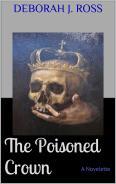 The newest entry in my lineup of stand alone fiction is The Poisoned Crown, now available here.
The newest entry in my lineup of stand alone fiction is The Poisoned Crown, now available here.The king is dead, long live the prince, but not for long if his stepmother the Queen Regent has anything to say about it. So he appeals to the one person he can trust, his father’s best swordswoman and the king’s secret lover. Venise wants nothing more than to bury herself in her grief at the king’s death, but her conscience will not allow her to abandon the young man who is so like his father. The only question is whether the two of them can stand against the Queen Regent’s black magic.
Here's what a reader had to say about it:
As to be expected, I thoroughly enjoyed this brief tale of the struggle of an honorable young Prince to be crowned King while his stepmother, the current Regent, tries everything in her power to prevent it while still appearing loyal to the nation. The main character, a former soldier and woman who had served and loved her King, the Prince's father, loyally for many years, uses her wit, skill, and experience to help the Prince save his country. ... The writing, characterization, and storytelling are excellent and this is an engrossing and fun read. ...This is really a story about family––identifying who you love and choosing to make a life that holds them and your mutual ideals close. Like all her stories and novels, I will remember A Poisoned Crown with great affection and recommend it highly.

May 28, 2021
Book Reviews: How to Become a Planet, by Nicole Melleby
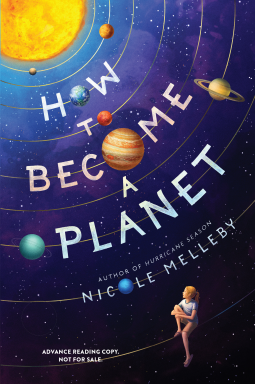
How to Become a Planet, by Nicole Melleby (Algonquin Young Readers)
Fourteen year old Pluto is an engaging youngster, as passionate about astronomy as she is puzzled by the changes in her life and herself. Within a short period of time, she’d gone from a happy science geek who hangs out with her best friend on the boardwalk where her divorced mother runs the family pizzeria, to a stranger in her own skin. Sometimes she’s paralyzed with the blues, unable to even get out of bed, and the next she’s caught up in senseless fury. It’s as if the mood swings of normally hormonal adolescence have been amped up to pathological proportions. Even with a supportive mother, a psychiatric diagnosis complete with medications and a recommendation for psychotherapy, and a novel way of using astronomical concepts as metaphors for what she’s going through, Pluto is drowning. Not only is she progressively alienating everyone she cares about, she’s stopped caring. Only when her rich city father ramps up the pressure for her to live with him does she formulate a desperate plan: a list of all the things she must do in order to stay at home.
Take medication.
Visit the planetarium with Mom.
Go to Former Best Friend’s Birthday party… and so on.
The list, Pluto believes, will prove that she can return to her old, “true,” “normal” self. But things don’t go as planned. As Pluto embarks upon her tasks, they become even less within her reach. The summer takes one unexpected turn after another. The tutor whom Pluto was sure she’d hated turns out to be a sympathetic ally, and a new friend with a checklist of their own has a secret Pluto can sympathize with.
Society tends to “other” people with mental illnesses. Historically, they were seen as possessed by devils or cursed by angry gods, as witches, or as eccentric, lazy, or selfish. Treatments ranged from trephination (drilling holes in the patient’s skull), to exorcism to locking the mentally ill in horrific prison-like asylums. Even today, when effective treatments allow many, even those with serious diagnoses, to lead functional lives, the stigma persists. All too often, the person is seen only as their illness, and their insights and contributions therefore dismissed as invalid. Young people are particularly vulnerable to public shaming. It’s hard enough for even “normal” teens to figure out who they are and what they want in life. How to Become a Planet focuses on Pluto as a sympathetic character, a person who is both resourceful and overwhelmed, insightful and confused by changes in herself. Her use of astronomy metaphors is particularly vivid and powerful. Above all, Pluto is a person whose brain chemistry isn’t working quite right, not a diagnosis, and this excellent novel showcases her journey toward a new balance in her life.
As for my personal reaction, I must confess that, although I am an older adult, I gobbled up this book. Pluto’s voice was so compelling, and her struggles so resonant, that the story connected with me on a deep level. Although I did not suffer depression as a teen, I struggled with PTSD as an adult. The times Pluto absolutely cannot motivate herself to engage with her day were chillingly familiar. And, just as Pluto took small steps toward understanding her “new normal,” that’s how it went with me. Besides skillful therapy and appropriate psychiatric medicines, unexpected acts of kindness and new friendships as well as old carried me through the dark times. Pluto comes to accept that she is now and will forever be different from who she was before. I can never go back to the person I was before my own trauma. But I can heal and grow and live a fulfilling life. I wish the same for Pluto. She’s made an excellent start.

May 21, 2021
Short Book Reviews: Stina Leicht's Persephone Station
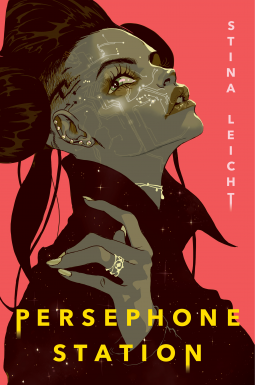 Persephone Station, by Stina Leicht (Saga Press)
Persephone Station, by Stina Leicht (Saga Press) A very cool premise underlies this novel: A lone corporate town on a planet that appears to be hostile to human life, but it’s all a hoax, a smoke screen designed to protect the native race from the rapacity of the dominant corporation. Throw in a crew of mercenaries, an AI in human guise, local politics, and desperate missions against impossible odds, and the result is a complex and innovative tale. Ambitious as the premise is, it’s also a balancing act for any novel to encompass such a multi-level plot along with character development and backstory. And as much as I wanted to love this book, and as many places as it drew me in, ultimately the proliferation of elements and fragmented pace kept losing my attention. I gave up 2/3 through the book, at a point when the dramatic tension of the oncoming conflict should have kept me glued to my seat but in fact I found myself falling asleep or looking for something else to read.
As both a reader and a fellow writer, I see a number of lessons here. Every piece of this book is well done – the prose is strong, the dialog snappy and true to each character, and those characters interesting and complex, the world itself and its alien inhabitants are well drawn, the mystery and the corporate danger both nicely handled. I’m sure that some readers will dive into the book and find it satisfying. For me, the attention paid to each element – for example, the backstory and relationships of each character – interrupted the forward momentum of the action and my ability to stay engaged with all the different parts that were eventually to come together. For long stretches, every time I connected with a character or immersed myself in a plot sequence, it was interrupted and I had re-orient myself. I don’t mind multiple POVs but I do mind being frequently catapulted from one focus to another. This is undoubtedly a personal taste, which is why I encourage readers who find the concept behind Persephone Station intriguing to give the book a try.

May 17, 2021
Guest Story: Love and Death in the Garden of the Heart, by Dan Rubin
I'm delighted to present this short piece by my friend, Dan Rubin.
Love and Death in the Garden of the Heart
by Dan Rubin
I love my garden. Everything I have ever cared about is right here. I know they call me "crazy old cat lady" but that is not the whole story.
This was the family home. We moved here in 1932 when I was very young. Papa worked for the railroad. This house was just a short walk from the yards, and it had everything we needed. This swing, well he made it for me, and even though I have replaced the ropes at least four times over the years, it is still the one he built and hung here from the branches of the old maple.
One reason I love my garden is that everything comes to rest here. It accepts whatever we can give it. This rich, dark soil is proof of that, fed by generations, fed by blood and bone you might say.
Soil is not dirt. I keep telling people that, when they visit, though many do not come by any more. They are all gone. But nature is generous with her gifts, returning everything to the soil in the end.
Where was I? Oh yes, you see that bed over there? That was dug by my first husband, Leroy. Heart shaped, he said, because it stood for his love for me. Well that was all fine, you see. Love is fine, if it is kind and gentle. But he snored! And when he was in his cups he grew mean. It took weeks for the bruises to heal. In the end, I had had enough. Dig it deep, I told him, and made sure he did, knowing the piles of soil would come in handy when he finally had his, well, his little accident with the shovel. As I said, the garden accepts what we give it.
It was Danny who laid out the paths. He arrived at exactly the right time, needed a place to stay, so I took him in. Nothing straight, I told him, everything must curve. Edges and borders, planted to nasturtium and hostas, to fill in the shaded parts. It came together very well. But after the night I caught him pilfering the silverware, I knew what I had to do. Everything feeds the soil.
And then there were the cats, so many generations of cats. Sometimes the little ones lived, but when there were too many in a litter, one has a simple choice: to find homes for them (my neighbours soon grew tired of being offered yet another kitten) or, in the end, return them to the earth. These lovely sunflowers, well every one of them is, in a sense, a kitten.
My second husband seemed to understand all that. He helped me finish the borders, planting lilacs and the hedge of blackberries that screens out the road, grown busier and busier through the years, though not so busy now that the railroad is gone, the tracks torn up and replaced by a four lane road. He was a good worker, while he lasted. But once his work was done, the garden more or less complete, there was another choice to make. The fruit trees, I thought, they need feeding.. He was perfect for that simple task.
Yes, there is so much richness, there are so many memories here. In the end, I am resigned to my own place in it. I am not shy about that. Not any more. "Like the lowly chambermaid we all must come to dust." As Yeats said, or Shakespeare or whoever it was. Dust to dust. All part of our journey.
But for now I sit, watch cats lounge in the bright morning sun, and sip my tea. That is enough. Yes, I do love my garden. Everything I care about is right here.
(c) 2021 by Dan Rubin. Used by permission
~ ~ ~

Dan Rubin is an award-winning author of fiction, non-fiction, poetry and journalism who grew up in California but now makes his home on the Atlantic Coast of Canada. He lives in a small town north of St. John's, Newfoundland where he works as an arts administrator and garden educator. Over the past forty years, his short fiction has won regional awards, been published, anthologized and produced for broadcast twice on CBC radio.
He is the author of four diverse books: the biography Salt on the Wind: The Sailing Life of Allen and Sharie Farrell (published by Horsdal and Schubart, 1996); a music collection, Tanglecove: 30 New Canadian Fiddle Tunes (Tanglecove, 2014); a community history, Pouch Cove: Our Home by the Sea (Pouch Cove Heritage Society, 2015) which won the provincial Manning Award for heritage preservation, and his first novel, a futuristic adventure story, A Fire on the Sea which was shortlisted in the Amazon first novel competition and published by First Person Press (2017). He continues to develop new works, and currently has four novels, a screenplay and three non-fiction books in development. Details of his writing and his music (he is also a songwriter and composer with twelve albums of original music released to date) can be found at www.danrubin.ca.
The painting is by Claude Monet, The Artist's Garden at Vétheuil, 1881.

May 14, 2021
Short Book Reviews: Telepathic Cats in Space Return!
Prime Deceptions, by Valerie Valdes (Harper Voyager)
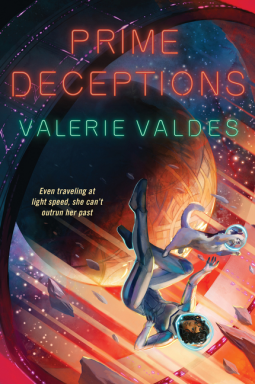
Captain Eva Innocente, dauntless hero of Chilling Effect (reviewed here) is back in action, along with her crew that are more like family than her real relatives. And those real relatives are back in her life, catapulting her into another adventure. This time it’s Eva’s sister, offering a huge reward for a missing scientist who just happens to be the brother of one of the crew. The chase leads Eva and her friends from one planet to another, through the halls of Evercon – home of the eternal sf/f/costume/gaming convention – and finally to a planet that Eva would just as soon forget. Enter, also, Eva’s mother, accountant extraordinaire, and a plot to take over the universe via Pokémon-like intelligent toys.
As in the previous book, smooth prose and colorful characters team up with a complex, long-view plot that has lots of action reversals, and quieter moments. The center of the story, though, is the love that binds together the crew of La Sirena Negra into a family-of-choice.

May 7, 2021
Very Short Book Reviews: A Werewolf's Mix-Tape, Murder Roses, and a Witty Urban Fantasy
Kitty's Mix-Tape, by Carrie Vaughn (Tachyon)
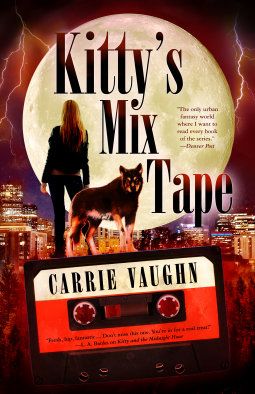
This delightful collection of short pieces – some previously published stories, others slice-of-life vignettes – is like a series of tea parties – or songs, if you will – from Vaughn’s urban fantasy world and its characters. Werewolves and vampires and selkies, oh my! Vaughn’s prosecraft and story-telling skills are up to their usual superb level.
The organizing thread is the werewolf DJ, Kitty Norville. I met Kitty (and some of the other characters) tangentially in other works set in this same world. I loved finding out more about them, peeking into the hidden corners of their better-known adventures. I suspect that those who are familiar with Kitty’s world and its denizens will derive particular delight in meeting them again, but the stories are so well told and carefully ordered that newcomers will not be lost, only enchanted.
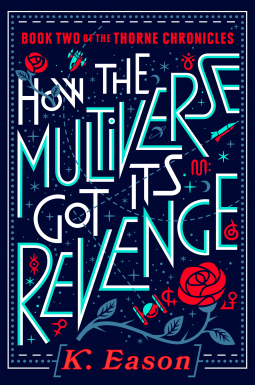
How the Multiverse Got Its Revenge, by K. Eason (DAW)
I adored K. Eason's novel, How Rory Thorne Broke the Multiverse, and had high hopes for its sequel, How the Multiverse Got Its Revenge. I found the same delightful, witty prose and innovate story elements. The sentient murder roses were hands-down my favorite character. However, the multiplicity of cultures and characters left me perpetually confused, especially if I set the book down for a couple of days, as readers often do. The story began clearly enough, but by a third of the way through, the murder roses in which I initially delighted were sidelined and it seemed that as soon as I got oriented (or re-oriented) to a given character's POV, I got switched.
Sequels and series are very much the thing these days, but too many novels that are wonderful stand-alones are then followed by sequels that amount to pale imitations or tortured attempts to create a follow-on plot to a story that is complete in itself. Alas, How the Multiverse Got Its Revenge falls into this category. K. Eason is such a talented and skillful writer, I think it would be better to go on to a new story, one that I will gladly read.
Brimstone Bound (Firebrand, Book 1), by Helen Harper
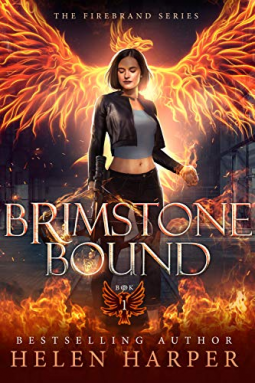
Helen Harper’s witty urban fantasies never fail to delight me, and Brimstone Bound is no exception. The first-person narrator, Emma Bellamy, has almost finished her training as a detective in London when she’s given her final trainee assignment: the Supernatural Squad. Although no one in their right mind wants such a post, she’s determined to make the best of policing the city’s vampires, werewolves, and assorted other “supes.” That is, until she herself is brutally murdered and wakes up in the morgue without a scratch on her. She’s not a vampire now, or a zombie, or anything anyone has heard of. Maybe her boss knows – oh no, now he’sbeen murdered, although it’s made to look like an accident.
Fast-paced, full of innovative plot twists, and always engaging, Harper’s latest is a quick, juicy read.

May 3, 2021
Romancing De-Extinction
I was – note the past tense – going to write a post about re-entry after Covid-19 vaccination and how awesome it was to give my younger daughter a hug after over a year, but then I saw this story from Science magazine and could not resist.
Did you ever wish you could see a living dinosaur? I sure did! (I still do…but from a safe

distance.) As a child I loved movies with stop-action animation of dinosaurs, like the original King Kong or the Ray Harryhausen movie, The Valley of Gwangi. In high school I wrote a short novel about two teenagers and their horses who discover a hidden valley where dinosaurs still roam. Jurassic Park and its sequels blew me away, the movies even more so than the novels. The novels were longer on explanation, the movies far more powerful in vividness. The moment when Alan Grant, upon learning that Professor Hammond has created a T. rex and almost faints, that’s how I would have felt. Great acting and directing aside, these books and films spoke to a universal or near-universal human longing to see amazing charismatic animals from the distant past.
The earlier stories, at least the ones I read and watched, made no effort at a scientific basis for the present-day existence of prehistoric animals. It was all “Land That Time Forgot” hand-waving. Crichton took a different tack: dinosaurs did not persist in some undiscovered corner of or beneath the Earth: humans re-created them using DNA preserved in amber. We’ve been able to recover DNA from Pleistocene mammals, but never anything as old as 65 million years. Many scientists doubt that DNA could survive that long, no matter how preserved. When an animal dies, its DNA begins to decay. A 2012 study on moa bones showed that genetic material deteriorates at such a rate that it halves itself every 521 years. This speed would mean paleontologists can only hope to recover recognizable DNA sequences the past 6.8 million years. In 2020, Chinese Academy of Sciences paleontologist Alida Bailleul and her colleagues proposed they had found a chemical signature suggestive of DNA in a 70 million year old baby hadrosaur fossil. If confirmed, this material would be so degraded into components, not sequences. It’s also possible the chemical signature was that of bacteria, not the dinosaur itself.

The Siberian permafrost that has yielded mammoth DNA is about 2.6 million years old, but freezing turns out to be a pretty good preservative of DNA. Scientists have now been able to sequence DNA from extinct mammoths 1.2 million years ago. That’s a world record. The previous record, in 2013, was from a 750,000-year-old horse. The new study includes DNA from three species of mammoth from three time periods (1.2 million, 1 million, and 700,000 years ago) and there are all kinds of reasons to be excited about it, not just the age but the evolutionary relationships and a previously unknown type.
Which brings us to the question we’re all asking: Once we’ve sequenced this DNA, whether from mammoths, saber-toothed cats, ground sloths, or whatever – what do we do with it?What we can do now is better understand the evolution and relationships of these amazing animals. What popular media want, however, is to use the material to create living extinct species. The process of de-extinction can proceed either by cloning – taking material from a recently extinct species and replicating it – or by using ancient, fragmentary DNA. We’ve got a long way to go with either technique. Many extinct species lack contemporary surrogates to carry the artificially created embryos to term. For others, suitable habitat no longer exists (really? Where would you turn a giant ground sloth loose? A saber-toothed cat? Or would these animals exist only in the unnatural environment of zoos?) Back in 2009, Spanish scientists cloned a newly extinct Pyrenean ibex, although the clone died within a few hours of birth.

There are, however, a few good candidates for which possibly viable DNA sources exist. Species like the passenger pigeon and Carolina parakeet might fare well, given the human responsibility for their disappearance, although they might turn out to be temporally invasive species.
Here’s the list that Tree-Huggerput together:
1. Woolly Mammoth
2. Tasmanian Tiger
3. Pyrenean Ibex
4. Saber-Tooth Cats
5. Moa
6. Dodo
7. Ground Sloth
8. Carolina Parakeet
9. Woolly Rhinoceros
10. Passenger Pigeon
11. Irish Elk
12. Baiji River dolphin (China)
13. Huia (New Zealand)
14. Neanderthal Man

Obvious ethical issues present themselves for some of these species (do we have the right to createa sentient being?), and loss of habitat for others. Some, like the Baiji River dolphin, are only recently extinct, so good DNA should exist. Tasmanian Tiger DNA might be preserved in specimen jars or taxidermy models.
When I think of these animals being resurrected (if that’s the right term to use for de-extinction), I feel torn. In Jurassic Park, Ian Malcolm points out that just because we can do something doesn’t mean we should. Part of me would love to see a living Irish Elk or a dodo or a dire wolf. Another part recoils at what the lives of those animals, especially the large, charismatic mammals, would be like. It’s hard enough seeing a modern tiger so stressed in its cage that it paces ceaselessly, but at least there are still tigers in the wild. A captive saber-toothed cat could never live in the same ecology as its ancestors: that world, and the prey animals that inhabited it, are gone forever. And the notion that some multi-billionaire might keep such animals as curiosities is just plain obscene.
 So I’m willing to encounter ground sloths and Smilodons in books and art and museum
So I’m willing to encounter ground sloths and Smilodons in books and art and museumdisplays and movies (that keep getting better, yay CGI!) I stand up and cheer as loudly as any paleontology nerd about understanding evolution and the marvelous creatures that have inhabited Earth in ages past. I’d love to see de-extinction technology applied to saving recently or on-the-brink extinct species like the Sumatran Rhino or the Bornean Orangutan. In the best of all possible worlds, prehistoric animals can teach us to be better stewards of those still living.

April 30, 2021
Short Book Reviews: Two Through-the-Magical-Door Adventures
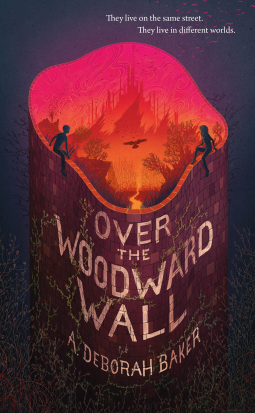
Over the Woodward Wall, by A. Deborah Baker (Tordotcom)
Two children, one a conformist, the other a spontaneous adventurer, find themselves transported to a magical world of beauty and peril. Avery is conventional, precise, analytical. Zib is an elemental force of courage and chaos. When their separate, parallel routes to school are blocked by construction, they take a short cut over a wall and end up in the land of Up and Under, befriended by owls and a Crow Girl, who periodically disassembles herself into a murder of crows. Occasionally guided by a glittering Improbable Road, they embark upon a journey home. Other character, both sympathetic and sinister, form often dangerous alliances with the children.
The narrative style is often humorous, always witty, as if the third-person narrator were a character in itself. I suspect that Seanan McGuire, writing as A. Deborah Baker, had a hugely entertaining time writing the book, as the reader will have reading it. A fast, entertaining read.
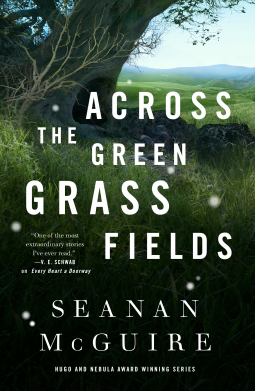 Across the Green Grass Fields, by Seanan McGuire (Tordotcom)
Across the Green Grass Fields, by Seanan McGuire (Tordotcom)At first I thought from the title that this was a sequel to Over the Woodward Wall (written as A. Deborah Baker), but Across the Green Grass Fields takes place in an entirely different world, with a new protagonist. The prose style is similar, as is the device of a door (or wall) through which children enter a magical world and their adventures there.
In this case, the child is Regan, whose abiding love in life is horses. Although growing up in a loving and supportive family, she’s insecure enough to seek the approval of a domineering, conformist girl. When she confides in her friend the newly disclosed information that she’s intersex (genetically XY but female in appearance, due to androgenic insensitivity syndrome, a neat bit of medical geekery1), her friend reacts with bigoted cruelty. Regan then escapes (through a magical door, of course) to a land where the first creatures she encounters are unicorns (gorgeous but dumb as rocks) and centaurs (an all-female family that accepts her without question into their loving home).
Immersed in the Hooflands, buoyed by her love of horses and things-horselike (murderous kelpies, for example), Regan grows into a competent, confident adult without the difficult question of which gender camp she fits into. Of course, all is not well in the Hooflands, and various adventures ensue.
I applauded a biologically intersex hero, and the way sex versus gender is beautifully depicted. Even more, having been a horse-obsessed teen myself, I appreciated the empowering and healing nature of the human-equine relationship. I’d love to see more stories like this2 – maybe McGuire will create them!
https://isna.org/faq/conditions/ais/Full disclosure: one of my children is a physician specializing in medical care for gender and sexual minorities.

April 26, 2021
New! Single Short Fiction Stories
Single Short Fiction Stories
In the past few years, I've put together collections of my short fiction (Transfusion and Other Tales of Hope; Pearls of Fire, Dreams of Steel; Azkhantian Tales). Now I've embarked on a different project: stand-alone single stories that can be read in a single sitting. The first five have never appeared in a collection, although they are reprints from recent volumes of Sword and Sorceress.
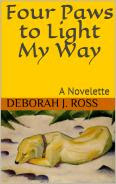
The first one, a novelette entitled, "Four Paws To Light My Way," features a blind swordswoman and her guide dog. The inspiration was our last German Shepherd Dog, a retired seeing eye dog named Tajji. Tajji was not only an amazing companion but a teacher, and I learned so much about what seeing eye dogs can do and the freedom and empowerment they bestow upon their humans.
 Tajji (2004-2016)
Tajji (2004-2016)I read the opening aloud at a pre-pandemic convention and everyone wanted to hear more. A few clamored for an entire novel about Jian and Dog. "Four Paws To Light My Way" will release on May 1, 2021, and is available now for pre-order. The others will follow at monthly intervals.
Four Paws To Light My Way (May 1, 2021)
The Poisoned Crown (June 1, 2021)
"The Fallen Man" (July 1, 2021)
The Girl From Black Point Rock (August 1, 2021)
Sage Mountain (September 1, 2021 -- not yet available for pre-order)
Eventually, I'll put them all together in a new collection. Stay tuned for further news!
As a special treat, and to launch this project, please enjoy this excerpt from "Four Paws To Light My Way."

April 23, 2021
Short Book Reviews: A Powerful Life-Swapping YA Novel
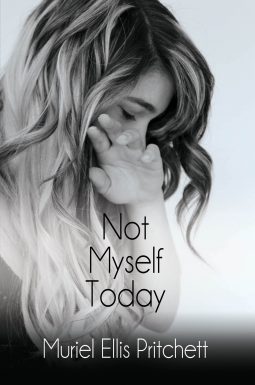
Not Myself Today, by Muriel Ellis Pritchett (Black Rose Writing)
I picked up this book, knowing little more about it than it partakes of the character-wakes-up-in-the-body-of-a-stranger-who-died-at-the-same-time story trope. Fine, I thought. I’m a fan of Drop Dead Diva. I’m game.
Our viewpoint character is Lindsey, college-bound high school soccer star, articulate, self-confident, with an awesome father and super best friend. In other words, a golden girl with a golden future. After collapsing at the end of a crucial soccer game, she wakes up in the hospital in a much younger body, beaten to a pulp. As the story unfolds, Lindsey goes through the expected motions of trying to convince her father that this bruised, unwanted fourteen year old is really her, while fending off a smelly, repulsively dependent girl who claims to be her roommate.
The story flows seamlessly from “Freaky Friday” to darker themes. It doesn’t take long for Lindsey to realize that her new body is that of a teenage runaway sex worker and the man who assaulted her was the pimp she’d been desperate to get away from. As Lindsey comes to understand the realities of her new identity, she also finds the courage to speak up for exploited girls like her. What begins as a light-hearted identity-swap story grows, as its narrator grows, into a mature, challenging, and transformative novel. One of the things I liked most about Lindsey’s growth was her acceptance that her new life will be different: she’ll have to repeat high school, albeit from a more mature perspective; soccer will be out of the physical capabilities of her new body, but not track and field or perhaps something else. And the geeky younger boy who idolized her infuriatingly might just turn out to be her new romance.
Although the body-swapping is technically a fantasy element, the story itself has a mainstream sensibility; nevertheless, fans of Young Adult fantasy will find the character development and meaty topics rewarding. Highly recommended.




